Passive vs Active talent
Before we dive into the art of engaging passive engineering candidates, let’s establish the difference between the two.
Active candidate is someone who is actively seeking new employment. Whether they are currently employed or not, as long as they are actively looking to change jobs and are applying for positions, they fall under the “active candidate” bucket. Passive candidate is the opposite. They are not actively seeking new opportunities and often times are happy where they are.
Why should you want to engage passive talent over active?
You are in competition with all the other companies who are actively trying to hire the same candidate you are trying to get on your team. Everyone is after active candidates.
Why? Because they are easier to engage with. But just because it’s easier does not mean it’s better, especially when it comes to hiring someone to help you develop or create of value.
Great candidates are usually employed.
On average, it takes 10 days for great employees to find new employers.
More than 70% of candidate pool consists of passive candidates.
There is little to no competition for you when you focus on passive talent. Not everyone has the ‘know-how’ or patience to go after the passive candidates. Since you are reading this, consider yourself among the few of the luckier ones. 😄
But wanting to go after them is not enough. You have to know how to engage their curiosity. Remember, they are passive for a reason. They are a stand-out talent, and they know it, and that is why they rarely find themselves having to actively seek new opportunities. Even if they happen to actively seek new opportunities, they are single only for a brief moment, until the right suitor snatches them up.
Opportunities come to them.
Now, how do you engage passive talent?
“If one does not know to which port one is sailing, no wind is favorable.” – Seneca
Establish Ideal Candidate Profile (ICP)
Before going live with the job post, get together with the engineering team and establish the ICP.
How would an ideal candidate look?
How would you know that you have identified the ideal candidate?
What would be their main responsibility? Are they going to be an Individual Contributor (IC) or someone who will lead the team effort?
We have a dedicated blog about crafting an ICP. Here is the link.
The Must-haves
This is important.
Most Hiring Managers whip-out a job description that has been either copy-pasted from a previous job or copy-pasted from another job posted by another company. Don’t be that company.
Know the main priorities for the role. If you took the time to craft an ICP, this part should be easier. For example, most Frontend engineering job posts have every tech-stack listed in it.
In reality, a solid frontend engineer, or any other engineer, only has to know 2-3 tech-stacks very well.
Here is a simplified heuristics broken down for a frontend engineering role:
#1. The programming language (That’s usually Javascript).
#2. Frontend library (Usually either React or Angular).
#3. Domain experience or knowledge. Examples like:
a. If company focuses on Cloud-based solutions, then experience/knowledge in Cloud technologies
b. If AI-based company, then experience building or working using AI on enterprise-level software product
c. If mobile application company, any experience developing on iOS/Android platforms using Native code or React Native
d. If payment processing, have they worked with payment gateway APIs.
Everything else is extra.
Adding Git, HTML, CSS, various databases, Unit testing, etc, is a waste of space and creates mental clutter for anyone who reads. Hiring Managers put everything on their job descriptions because they are afraid to miss something important. That comes from not understanding the nuts and bolts of the job duties from the technical side.
Gather with your technical team and get 2-3 must-haves from your engineering team.
Here are few real-life job descriptions from FAANG companies. Notice how simple their job descriptions are.
Example #1: Screenshot of a JD for a FE role at Amazon
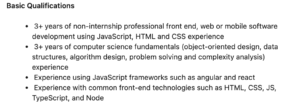
Example #2: Another screenshot for a level 3 SE role at Microsoft

Example #3: One more example for a level 4 SE role at Netflix

That’s it!
Pitch in your job description
When companies want to raise money, they pitch. When they want to onboard new customers, they pitch. So how is hiring any different? Converting your job description from a kitchen manual to a candidate sales pitch is the lowest hanging fruit with the highest ROI. Because so many job descriptions are cut and dry that if your company has pitch-like read in the job post, you instantly stand-out from the crowd. FAANG companies are FAANG companies for a reason. They attract best engineers.
Even before they were the giants we know them to be today, these FAANG companies were hyper-obsessive about hiring.
Candidate Experience
Candidate experience is critical when engaging passive talent.
Passive candidates are used to being courted and having opportunities brought to them. You need to match that experience with personalized outreach and thoughtful interactions. This level of care makes candidates feel valued as individuals, not just resumes.
Take a look at these 2 stats found by CareerBlog.com.
81% of candidates reported that positive candidate experience influenced their decision to accept the offer. And 49% of job seekers declined a job offer due to the poor candidate experience.
Bottom line: Pay attention to the candidate experience when recruiting passive talent.
Specificity, specificity, specificity
Specificity is key in getting passive candidate’s attention.
In your outreaches be as specific as you can. Make them feel special. As if the message was personally written to them. Most recruiters in the tech scene use the “spray and pray” approach. They throw all the tomatoes they have on the wall and hope something will stick. Eventually something does stick. But not the most ripe tomato.
Here are few examples of what NOT to do.
Example #1: How overwhelming is this?
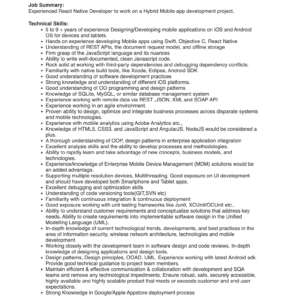
Example: #2: Same with this.
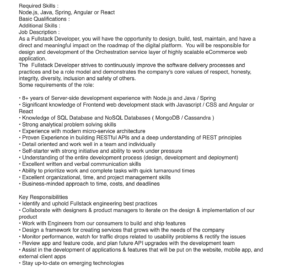
Only the most desperate candidates will bite the bait on those outreaches. But with great candidates your recruiters pretty much have lost any authority or credibility from that point on.
To illustrate, here are some examples of good personalizations.
Example #1: My outreach to a former distinguished Amazon Engineer.
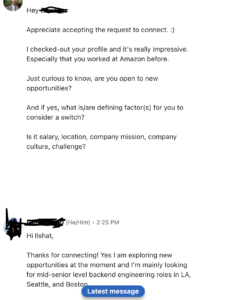
Example #2: To a former Meta Engineer who just joined a new company.
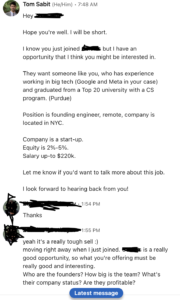
Example #3: Very short message but still very personalized.
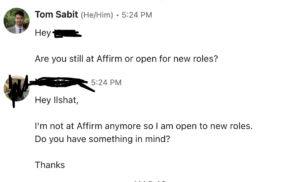
We all are humans, and we want to feel special and are pulled to people who make us feel that way.
Technical requirements
You got an amazing potential candidate interested and were able to get them on the phone. Great!
The recruiter better be prepared, because a candidate will ask deeper technical questions about the role. It’s bad if the recruiter can’t provide answers to the candidate’s technical expectations and about the company. You know what is worse? When a recruiter has all the confidence in the world while explaining, but are utterly clueless in what they say.
You just lost a great candidate and the recruiter doesn’t even know it.
Here is the truth, technical recruiting is broken.
Yet there is massive demand for recruiters and anyone can become a tech recruiter. Even real estate agents need to pass the test to be able to sell a house. But when it comes to recruiting, barrier for entry is non-existent, which is why there is disconnect between candidates and the employers. The connecting thread/mediator between the 2 parties (employee and employer) is the recruiter.
And when the recruiter is clueless and has no technical background, you get the sh*t show of what we come to know as modern-day recruiting.
If technical recruiting was done by the professionals who had experience writing software, none of the problems we’ve discussed above would exist. Yet, here we are. Here are some of the problems that would never see the light of day:
- Understand the technical demands for the position needed
- Craft a specific job description with only relevant details and priorities
- Provide the necessary feedback and information for the Hiring Managers
- Find, vet, and properly technically screen candidates
- Connect effortlessly with the most qualified talent
- Only send the most relevant candidates for interview rounds
- Keeping the interview pipeline filled only with the most relevant talent
- Giving relevant feedbacks to the engineering teams and the Hiring Managers
I worked for 7 years as a software engineer.
As my experience grew, I would join the interview panels to interview candidates. The candidates we would get from partnering staffing agencies and internal recruiting teams, would be beyond bad. We would waste weeks and months finding a good candidate to interview. This would happen with every company I joined.
This is why we started BlueBridge Solutions.
Here is our shameless plugin. If you are facing any of the issues we mentioned above, reach out to us. We can help your org and get you All-Star software engineers and handle everything from crafting a job description, finding, vetting, assessing, and helping you hire the right candidate for your org.
Back to the blog.
Interview Experience
The interview is the candidates’ chance to get to know your company culture and team. It’s also when they decide whether this opportunity is the right fit for them.
Keep your interviews focused and relevant to the role.
For example, if you need a frontend engineer with React experience, dig into the details of React-based projects they’ve worked on. For instance, if the role involves refactoring legacy code, you can ask this: “Tell me about a time you had to refactor a large legacy codebase and what strategies did you use to understand and improve the existing code?” If possible, the best option would be to pair program with a candidate and provide a code snippet exercise where the candidate has to refactor a legacy code. In case of React, you could provide a class-based component and have the candidate refactor to a function-based component.
You should be able to tell right away if the candidate really worked using React and how extensive is his/her experience simply from 1 real-world scenario question.
Also, don’t drag out the process with endless rounds of interviews and leave them hanging waiting for a feedback. Therefore, set expectations upfront on the number of interview rounds and timeline. Then stick to it. Passive candidates especially have many options – a drawn out process may cause them to lose interest.
According to LinkedIn’s Global Talent Trends report, a staggering 94% of candidates want to receive feedback after an interview. What’s more, providing them with constructive criticism increases the likelihood of them considering your company for future roles by 4 times.
Don’t leave them hanging for weeks. Let them know timelines or if any delays come up. For example, simply following up quickly shows the candidate you’re excited about them.
To put it shortly, the interview experience is your chance to show candidates why your company should be their first choice. Make sure it leaves them with that impression.
In Summary
To sum it up, in the world of talent acquisition, finding the best talent means understanding both active and passive candidates.
While the allure of active candidates may seem immediate, the real gems often lie within the pool of passive talent. Thus, by fostering meaningful connections, understanding technicalities for job requirements, and personalizing outreach efforts, recruiters can unlock the door to exceptional talent through the art of engaging passive candidates.
Reach out to us if you are struggling with finding the right engineering talent.
At BlueBridge Solutions, we recognize the significance of this approach, and we believe that software engineers should recruit for other software engineering roles and handle end-2-end process of finding and hiring competent software engineers.